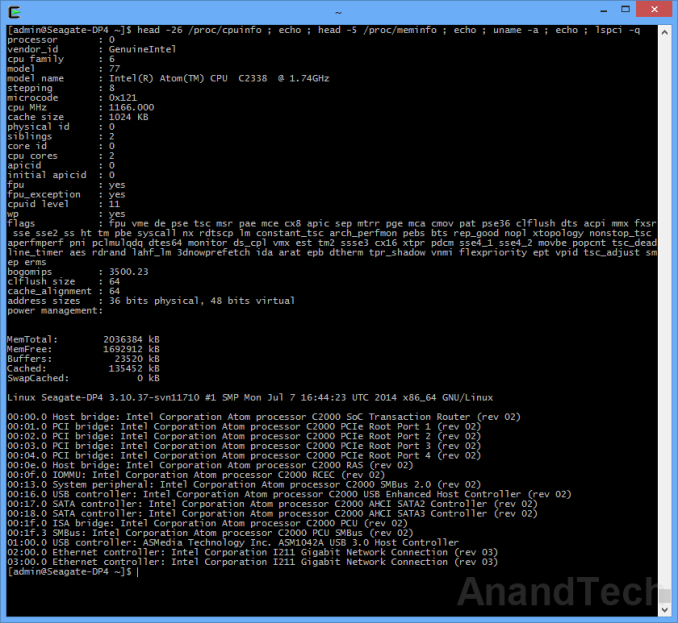Seagate's Intel Rangeley NAS Pro 4-bay Review
by Ganesh T S on August 27, 2014 7:00 AM ESTPlatform Analysis
The higher end segment of the SOHO / SMB NAS market uses Intel's Core-series and Xeon CPUs to deliver the required performance while supporting a large number of drive bays (typically more than 8, in a rackmount form-factor). Over the last four years or so, Intel's play in the other tiers has been mainly with its Atom CPU lineup. Back in 2010, Intel pushed the 45 nm Atom D410 / D510 / D525 for NAS units. In 2012, it was the 32 nm Atoms, the D2550 and D2700. All of these were based on the in-order Bonnell microarchitecture which was fast becoming dated compared to the advancements being made by the ARM SoC vendors.
In moving from 32nm to 22nm, Intel completely revamped the microarchitecture for their Atom cores. Bonnell was replaced by Silvermont, bringing out of order execution and other improvements into the picture. Silvermont's applicability to a variety of power profiles meant that there were multiple product lines that ended up using the CPU cores. Bay Trail is proving very effective in tablets and it is also the platform for QNAP's TS-x51 and TS-x53 Pro NAS series. Merrifield and Moorefield are trying to break into smartphones, but it is Avoton and Rangeley that are more relevant to the market that Seagate hopes to target with the NAS Pro units.
The different product lines integrate different I/O around the Silvermont cores depending on the target market. Avoton is meant for microservers and cloud storage platforms, while Rangeley is meant for communication and network infrastructure. Both of them integrate similar I/O around the cores, but the Rangeley parts have an updated crypto engine. The block diagram of a generic Rangeley part is provided below.
There is a wealth of I/O (2x SATA Gen 3, 4x SATA Gen 2 and up to 16 PCIe 2.0 lanes) for the storage subsystem, and the parts also support up to four GbE network links. From the NAS Pro 4-bay's viewpoint, the above block diagram should be considered in the context of the information gleaned via SSH access to the unit.
The NAS Pro 4-bay uses the Intel Atom C2338 SoC which has two Silvermont cores running at 1.74 GHz. It is backed up by 2 GB of DRAM. The Atom C2338 has 8 PCIe 2.0 lanes, The ASMedia ASM1042A PCIe to USB 3.0 bridge provides the two USB 3.0 ports in the system. The two network parts are enabled by two Intel I211 Ethernet Controllers. Obviously, in a platform like Rangeley, no SATA - PCIe bridges are needed. Note that the unit uses the SATA Gen 2 ports on the SoC directly for the four drive bays. Users can connect 6 Gbps SATA drives to these, but the performance will top out at SATA Gen 2 rates (3 Gbps). Since the target market / use-case for the NAS Pro 4-bay doesn't involve SSDs, this is not an issue.
On the software front, the NAS Pro runs Linux (kernel version 3.10.37). Unlike the ARM-based NAS lineup, the NAS Pro uses a BIOS for booting. From a software perspective, the interface and usage is the same for both the NAS and the NAS Pro. Since we have already covered the UI and other aspects in the NAS 4-bay review, we won't go into the details here. An important point to note, however, is the fact that there is full support for 802.3ad dynamic link aggregation with the two network links. In the NAS 4-bay, the two links could be configured for failover only. The extra platform power in the NAS Pro enables a fully bonded 2 Gbps link.












13 Comments
View All Comments
cletus_slackjawd - Sunday, November 2, 2014 - link
I really like this idea. I have an old Buffalo TerraStation 4x500gb that I have outgrown. Instead of replacing with another 4bay NAS I'll look for a single or dual and just buy a second as the backup. I never made consistant backups of my current NAS and as you stated, one hardware failure away from losing my data without expensive and time consuming fix.Jeff.Adams - Monday, November 10, 2014 - link
I just inquired about buying a 4 or 6 bay Seagate NAS Pro and the vendor told me that Seagate only certifies their own drives to run in these NAS appliances. Your review was with WD drives so obviously the NAS works just fine with other brands. And obviously Seagate isn't going to sell it's own NAS with someone else's drives in it. Would Seagate not warranty the NAS if I put HGST drives in it? And if I *must* buy Seagate drives to get full warranty coverage, do you like the models that they come with?Thank you :)